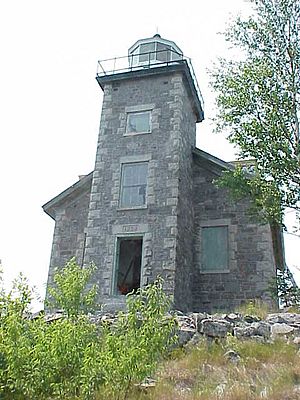Huron Island Light facts for kids
 |
|
| Huron Island Light as seen in 2006 | |
|
|
|
| Location | Lighthouse Island, Powell Township, Marquette County, offshore from Big Bay, Michigan |
|---|---|
| Coordinates | 46°57′48″N 87°59′54″W / 46.96333°N 87.99833°W |
| Year first constructed | 1868 |
| Year first lit | 1877 (current tower) |
| Automated | 1972 |
| Foundation | surface rock |
| Construction | granite/brick |
| Tower shape | square |
| Markings / pattern | natural with white lantern |
| Height | 39 feet (12 m) |
| Focal height | 197 feet (60 m) |
| Original lens | 3½-order Fresnel lens |
| Range | 15 nautical miles (28 km; 17 mi) |
| Characteristic | White Fl 10 seconds |
| Fog signal | none |
| ARLHS number | USA-395 |
| USCG number | 7-14730 |
The Huron Island Light is a historic lighthouse located on Lake Superior in Michigan, close to Big Bay, Michigan. It stands on one of the Huron Islands, which are part of a special wilderness area. This lighthouse was added to the National Register of Historic Places in 1975, recognized for its importance to history.
Contents
History of the Huron Island Light
Why a Lighthouse Was Needed
In the mid-1800s, many ships traveled on Lake Superior. They carried valuable copper from the Keweenaw Peninsula to other places. However, the Huron Islands area had many hidden reefs (rocky areas just below the water) and shoals (shallow areas). These were very dangerous for ships. The area was also often covered in thick fog, making it even harder for captains to see.
This spot was especially tricky because ships had to turn here to enter different bays, like Huron Bay or Keweenaw Bay. Sailors needed a clear warning to avoid crashing into the islands or shallow spots.
The Arctic Shipwreck
A famous event happened in 1860 that showed how dangerous this area was. A large ship called the S.S. Arctic crashed into the easternmost of the Huron Islands. Luckily, everyone on board, including passengers, crew, and even cattle, was safely taken off the ship and onto the island. Because of the cattle, that island is still known as "Cattle Island" today! Even though no lives were lost, this shipwreck made it clear that a lighthouse was desperately needed.
Building the Lighthouse
In 1867, the United States government decided to build a lighthouse in the Huron Islands. They set aside $17,000 for the project. A survey team picked the highest point on Lighthouse Island, which is the westernmost island in the group. This spot was chosen so the light could shine far and wide.
The lighthouse was built in 1868. Along with the main tower, workers also built an oil house (to store the lamp's fuel), a boat dock, and a small tramway to move supplies. The light first shone on October 20, 1868. At 197 feet (60 m) above the water, its light is one of the highest in the western Great Lakes.
Changes and Upgrades Over Time
Over the years, the Huron Island Light received many upgrades. In 1881, two buildings were added to house fog signals. These signals would make loud noises to warn ships when fog made it impossible to see the light. At first, they used steam whistles, but later they were changed to a different type of horn called diaphones.
The lighthouse was damaged by a lightning strike in 1891, but it was quickly repaired. In 1912, the light itself was improved to use brighter incandescent oil vapor. By the 1930s, the entire station was powered by electricity.
In 1961, a new building for the lighthouse keepers was constructed. A few years later, in 1972, the lighthouse became automated. This meant that machines took over the job of keeping the light running, so lighthouse keepers were no longer needed. The lighthouse building was then boarded up, but the light itself still works today as an important aid to navigation.
In 2006, the roof of the lighthouse building was replaced to help protect it.
Protecting the Lighthouse
A special group called the Huron Island Lighthouse Preservation Association was formed to help save and care for the lighthouse. It's a challenging task because the lighthouse is on an island that is hard for people to visit. However, this group is part of the Michigan Lighthouse Alliance, which works to protect many lighthouses in Michigan.
Description of the Lighthouse
The Huron Island Light looks very similar to other lighthouses built around the same time, like the one on nearby Granite Island. It is a 1½-story building made of strong granite stone. A square light tower, which is 39 feet (12 m) tall, is built right into the main structure.
When it was first built, the light used a special type of lens called a 3½-order Fresnel lens. This lens was made of cast iron and had ten sides, helping to focus the light into a powerful beam.
Today, the lighthouse and the island it stands on are owned by the United States Fish and Wildlife Service.
Visiting the Huron Island Light
The Huron Island Light is located on an island, so you can only reach it by private boat or a special tour boat. Of all the Huron Islands, Lighthouse Island is the only one that is open to the public. However, the lake waters around the island can be rough, cold, and dangerous, with many hidden reefs and shoals. The trip is about three miles from the mainland and should only be attempted with great care and proper safety gear.
Images for kids





